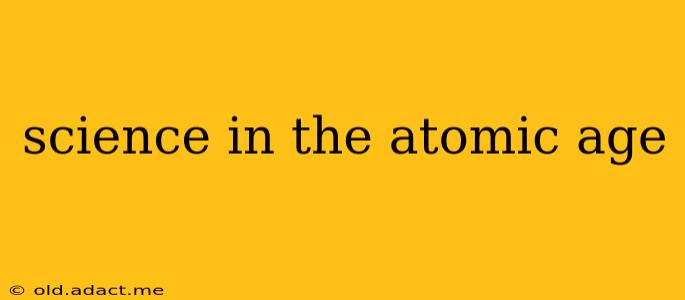The Atomic Age, ushered in by the Manhattan Project and the bombings of Hiroshima and Nagasaki, irrevocably altered the course of human history. It wasn't just about the devastating power of nuclear weapons; it represented a paradigm shift in scientific understanding, technological capabilities, and societal anxieties. This era witnessed an unprecedented acceleration in scientific advancements, particularly in physics, chemistry, and biology, fundamentally reshaping our world.
What were the major scientific advancements of the Atomic Age?
The Atomic Age fueled a surge in scientific discovery across multiple disciplines. The most obvious advancement was in nuclear physics. The understanding of atomic structure and the harnessing of nuclear energy led to the development of nuclear reactors for power generation and, unfortunately, nuclear weapons. Beyond nuclear physics, the era saw significant breakthroughs in:
- Particle physics: The development of particle accelerators allowed scientists to probe the fundamental building blocks of matter, leading to the discovery of numerous subatomic particles and the development of the Standard Model of particle physics.
- Materials science: The need for materials capable of withstanding extreme conditions (like those in nuclear reactors) spurred innovation in metallurgy, ceramics, and polymer science. This resulted in stronger, lighter, and more durable materials with a wide range of applications.
- Medical science: Radioisotopes, a byproduct of nuclear research, found crucial applications in medical diagnostics and treatment, leading to advancements in imaging techniques (like PET scans) and cancer therapy (like radiotherapy).
- Space exploration: The Cold War competition between the US and the Soviet Union drove significant advancements in rocketry and space technology, ultimately leading to the Space Race and the exploration of outer space.
What is the difference between the nuclear age and the atomic age?
The terms "nuclear age" and "atomic age" are often used interchangeably, and there's no strict, universally agreed-upon distinction. However, a subtle difference can be argued:
- Atomic Age: Often refers to the initial period following the discovery of nuclear fission and the development of the atomic bomb, emphasizing the initial scientific breakthroughs and the immediate aftermath of the bombings.
- Nuclear Age: Encompasses a broader period, encompassing the continued development and application of nuclear technology, including nuclear power generation, nuclear weapons proliferation, and the ongoing challenges of nuclear waste management. Essentially, it's a more encompassing term reflecting the long-term consequences and ongoing relevance of nuclear technology.
How did the Atomic Age impact society?
The impact of the Atomic Age on society was profound and multifaceted:
- Geopolitical shifts: The possession of nuclear weapons drastically altered the global power dynamic, leading to the Cold War and a constant threat of nuclear annihilation. The development of nuclear deterrence strategies shaped international relations for decades.
- Technological advancements: The scientific breakthroughs of the Atomic Age spurred innovation in various fields, leading to advancements in computing, medicine, materials science, and many others. This resulted in improved living standards and technological progress.
- Environmental concerns: The use of nuclear energy and weapons raised significant environmental concerns, including the dangers of nuclear waste and the long-term effects of nuclear radiation. This spurred the development of environmental regulations and increased awareness of environmental risks.
- Ethical dilemmas: The destructive power of nuclear weapons raised profound ethical questions about the responsibility of scientists and the potential consequences of technological advancement. This led to increased public engagement in scientific and political decision-making.
What are some of the ethical concerns surrounding science in the Atomic Age?
The Atomic Age highlighted crucial ethical concerns related to scientific research and its applications:
- The responsibility of scientists: The development of nuclear weapons raised questions about the ethical obligations of scientists in pursuing research that could have devastating consequences. The debate over the moral implications of scientific discovery continues to this day.
- Nuclear proliferation: The spread of nuclear weapons technology poses a significant threat to global security. The ethical challenge of preventing the acquisition of nuclear weapons by rogue states or terrorist organizations remains a pressing concern.
- Environmental impacts: The long-term environmental consequences of nuclear technology, including nuclear waste disposal and the potential for accidents, present significant ethical challenges. Balancing the benefits of nuclear energy with the risks to the environment requires careful consideration.
What is the legacy of the Atomic Age?
The Atomic Age's legacy is complex and multifaceted. It brought about incredible scientific advancements and technological progress, improving healthcare, communication, and daily life for many. However, it also cast a long shadow, leaving behind the threat of nuclear war, environmental contamination, and enduring ethical dilemmas. Understanding the scientific advancements, societal impacts, and ethical challenges of this era is crucial for navigating the complexities of the 21st century and ensuring a responsible future for science and technology.
